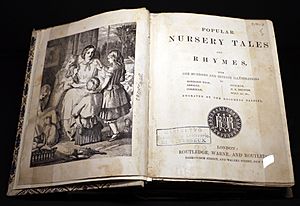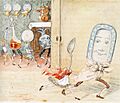Nursery rhyme facts for kids
A nursery rhyme is a traditional song or poem taught to young children. These short verses are often fun to learn. Sometimes, you might even do special actions or dances while singing them! Learning nursery rhymes can help kids learn new words and practice counting. For example, "Eeny, meeny, miny, moe" is a rhyme often used in counting-out games.
The term "nursery rhyme" has been used since the 1700s or early 1800s. In North America, people often call them Mother Goose Rhymes. This name started being used in the mid-1700s.
Some well-known nursery rhymes include "Three Blind Mice", "Jack and Jill", and "Hey Diddle Diddle".
Many cultures around the world have songs and verses for children that are passed down through families. However, the term "nursery rhyme" usually refers to those that come from Europe. The most famous ones are English and started in the 1600s or later. But some are much older! For instance, "Baa Baa Black Sheep" has been written down since the Middle Ages. The most famous collection of these rhymes is often linked to Mother Goose. Some popular nursery rhymes, like "Mary Had a Little Lamb", even started in America.
Contents
History of Nursery Rhymes
Lullabies: Songs for Sleep
The oldest children's songs we know about are lullabies. These are gentle songs meant to help a child fall asleep. You can find lullabies in every culture around the world. The English word "lullaby" probably comes from the soft sounds like "lu, lu" or "la la" that parents or caregivers make to calm babies. It also might come from "by by" or "bye bye", which means good night.
For a long time, lullabies were only written down by accident. One very old Roman lullaby, "Lalla, Lalla, Lalla, aut dormi, aut lacta" (which means "Lalla, Lalla, Lalla, either sleep or nurse"), was written down in an old book about a Roman poet. Many old English verses about the birth of Jesus were also sung like lullabies.
Most lullabies we know today became popular in the 1600s. For example, the famous lullaby "Rock-a-bye, baby on a tree top" wasn't written down until the late 1700s. It was printed by a publisher named John Newbery around 1765.
The First Nursery Rhymes

A French poem from the 1200s, similar to "Thirty days hath September" (which helps you remember how many days are in each month), was one of the earliest recorded children's rhymes. From the later Middle Ages, we have records of short rhyming songs for children, often written in the margins of books. By the mid-1500s, these rhymes started appearing in English plays.
"Pat-a-cake, pat-a-cake, baker's man" is one of the oldest English nursery rhymes still known today. The first time it was written down was in a play from 1698. Most nursery rhymes weren't written down until the 1700s. This was when children's books started to be more about fun than just learning. But many rhymes existed before this, like "To market, to market" and "Cock a doodle doo", which date back to at least the late 1500s.
The very first English collections of nursery rhymes were Tommy Thumb's Song Book and its follow-up, Tommy Thumb's Pretty Song Book. These were likely published in London before 1744. The songs in them became known as 'Tommy Thumb's songs'.
Later, in 1780, John Newbery's stepson, Thomas Carnan, was the first to use the name "Mother Goose" for nursery rhymes. He published a book called Mother Goose's Melody, or, Sonnets for the Cradle. These rhymes came from many different places, including traditional riddles, proverbs, and ballads (story-songs). About half of the "traditional" English rhymes we know today were already popular by the mid-1700s.
Nursery Rhymes in the 1800s
In the early 1800s, printed collections of rhymes began to spread to other countries. This included Popular Rhymes of Scotland (1826) by Robert Chambers and Mother Goose's Melodies (1833) in the United States. From this time, we sometimes know who wrote the rhymes and where they came from.
For example, "Twinkle, Twinkle, Little Star" uses the tune of an 18th-century French song called "Ah vous dirai-je, Maman". The words were written in the 1800s by an English poet named Jane Taylor in her poem "The Star".
People who collected folk songs also often collected nursery rhymes. This included Sir Walter Scott in Scotland and the German writers Clemens Brentano and Achim von Arnim.
The first important academic collection of nursery rhymes was The Nursery Rhymes of England (1842) by James Orchard Halliwell. He later published Popular Rhymes and Tales in 1849. In these books, he sorted rhymes into different groups, like historical rhymes, game rhymes, alphabet rhymes, and lullabies.
Nursery Rhymes in the 1900s
The early 1900s were famous for the beautiful pictures in children's books. Artists like Randolph Caldecott created Hey Diddle Diddle Picture Book (1909), and Arthur Rackham illustrated Mother Goose (1913). The most complete study of English rhymes was done by Iona and Peter Opie.
Images for kids
-
Illustration of "Hey Diddle Diddle", a well-known nursery rhyme
-
"Baa, Baa, Black Sheep", from a 1901 illustration by William Wallace Denslow





